I a far away place, a long time ago.....

Please see Swanica's page here: http://swanceramics.blogspot.com/2006_07_01_archive.html
Images and tex from her blog below:
THURSDAY, JULY 13, 2006

Yesterday, I got the news that my "Horsehair Vase" was accepted in "The 6th Mashiko International Ceramics Competition 2006 of Japan". And the piece received a Judges' Special award, selected by the artcritic Rupert Faulkner. The prize winning works will be displayed at the Mashiko Museum of Ceramic Art from October 8 to December 10, 2006 in Japan.
Mashiko is an important potter’s village, made known by Hamada Shoji, the legendary pioneer of Japan’s pottery folk art movement. Mashiko represents the essence of the old Japan and a unique reservoir of local clay and hills suitable for the "nobori-gama" kilns. Hamada was convinced that outstanding craftsmanship flows from the natural environment. His vision was about fusing nature's grace and beauty with pottery's functional forms. He has a career-long devotion to the use of the delicate clay indigenous to Mashiko and was honored to be a "National Living Treasure".
My website: www.swanceramics.com
WEDNESDAY, JULY 12, 2006
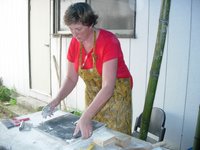
My first ANAGAMA firing in Lee Love's kiln.
First, we clean the shelves from the former firing, so the shelves will be even and nice.
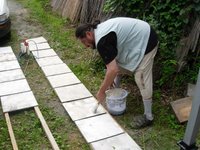
Lee paints the shelves with kiln wash, so, when accidents happen, and pots stick, it will be easier to take of the shelf.
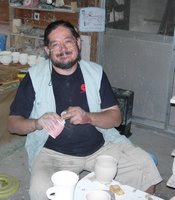 Then we glazed our pots.
Then we glazed our pots.Lee smiles relaxed and has everything under control!
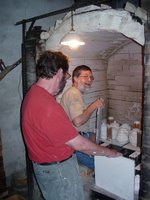
Jim and Hank fill the anagama. The two stoke holes are in the front. The fire goes through the flues and the flames shoot up in the back where the fire is the hottest.
 Jim and Adriaan, my husband, sawing the waste wood for the fire in smaller pieces.
Jim and Adriaan, my husband, sawing the waste wood for the fire in smaller pieces.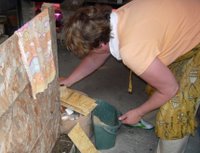 Weighing the wood, so that, every time you put wood in, the amount is the same: 2 Kg or 1.5Kg. First, every 10-15-20 minutes, but slowly building up to every 2-3 minutes till cone 13. This is around 2410 F or 1320 C.
Weighing the wood, so that, every time you put wood in, the amount is the same: 2 Kg or 1.5Kg. First, every 10-15-20 minutes, but slowly building up to every 2-3 minutes till cone 13. This is around 2410 F or 1320 C.
You have to stoke when no flames are shooting out anymore from the peephole.
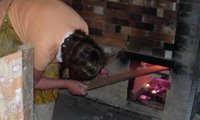
Stoking the anagama.
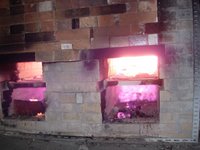
The stoke holes. By looking in the holes you can tell that the fire is already quite hot.
Unfortunately, we had to leave the next day. The kiln had to cool for several days.
I'll show you my results in one of my next blogs.
Hank and Jim traveled with me and Adriaan back to Kamakura, where they stayed for 2 nights.
We still has some other interesting visits.
We had a fabulous meeting with Yoshihiro Takishita at his home high up on Genji-yama (mountain) of Kamakura. He is an architect and antique collector/dealer. He moved and restored a gashi-type of farmhouse (snow country) and we got a tour from ground to attic and he showed us his screen collection dating from the Muromachi period. (The era when members of the Ashikaga family occupied the position of shogun is known as the Muromachi period, named after the district in Kyoto where their headquarters was located; 1392-1573).
He is the architect responsible for the restoration of the Yanagi home across the street from the Mingei-kan in Tokyo.
Next day, we went to see Robert Yellin, who lives in Mishima.
Robert Yellin has lived in Japan since 1984. His passion and deep interest in Japanese pottery has led him from collector to columnist and web host/dealer. He is an very knowledgeable and interesting collector and he very generously spent the afternoon showing us and talking about every pot in his office and gallery.
In 2 days, I will go back to the US for 3 1/2 weeks and see my youngest and oldest boys, do a lot of administration and financing and try to throw and fire lots of pots for future shows and "omiyage" (gift giving) in Japan.
TUESDAY, JULY 11, 2006
 Of course we also visited Lee's workshop and anagama in which we did a firing.
Of course we also visited Lee's workshop and anagama in which we did a firing.Lee Love is the organizer of this Mashiko gathering workshop in visiting a lot of prominent Mashiko potters.
He did a wonderful job and I think we were all able to see some divinity in the masters of Mashiko and nature around us and to find some of it in ourselves.
This is Lee's "Ikuru" ("To Live"!) anagama (one chamber wood fire kiln).
The kiln is a modern, high efficient, woodkiln using waste wood for fuel, which is friendly to the environment.
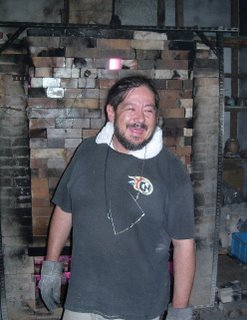 Lee makes functional pottery in an effort to preserve local culture in our modern throw-away society. His main goal is to inspire other people to make their own creative work. Human beings have always worked with their hands. "We are creators", he says. "We need both creativity and Nature to be healthy and whole human beings. Making and using handmade pottery is one way to bring nature and culture together in human life".
Lee makes functional pottery in an effort to preserve local culture in our modern throw-away society. His main goal is to inspire other people to make their own creative work. Human beings have always worked with their hands. "We are creators", he says. "We need both creativity and Nature to be healthy and whole human beings. Making and using handmade pottery is one way to bring nature and culture together in human life".Lee stokes the anagama.
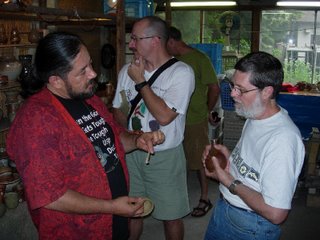 He was an apprentice for Shimaoka Tatsuzo from 2000-2003. Then he established his kiln and studio in Mashiko. He studies the cycles of nature, farming and their relationship to traditional pottery making.
He was an apprentice for Shimaoka Tatsuzo from 2000-2003. Then he established his kiln and studio in Mashiko. He studies the cycles of nature, farming and their relationship to traditional pottery making.Lee talks to Jim Laub, while Mike Martino looks at Lee's display.

Lee shows the rope rolling inlay.

This is the wood fired result "guinomi".

Display of Lee's work.
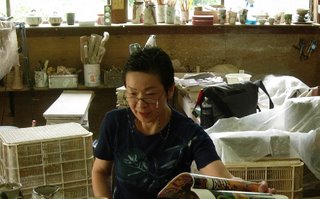
Yochiko-san works in her studio by herself.
She was an apprentice "deshi" from another quite well-known potter from Mashiko: Takauchi Shugo.
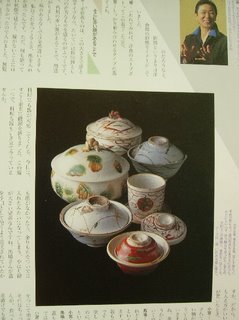
Her work is beautiful: white slip with on top an elegant free design.
 She also makes "Oribe" ware with this special green glaze.
She also makes "Oribe" ware with this special green glaze.Oribe ware is a high-fired ware that originated around 1600. This ceramic style is named after tea master and warrior Furuta Oribe (1545-1615). General features include a dark green copper glaze, white slip, underglaze brush work, and use of clear glaze.
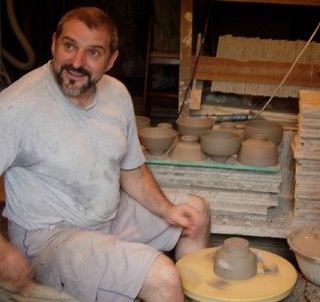 Euan Craig comes from Australia and was an apprentice for Shimaoka for quite some years, before establishing his own kiln in Mashiko.
Euan Craig comes from Australia and was an apprentice for Shimaoka for quite some years, before establishing his own kiln in Mashiko.Now, he lives in Ichikai, in the country. We had a beautiful drive to his house, where he lives with his family and offered us a cafe latte!!!
He has developed a variety of innovations, currently concentrating on creating wood fired porcelaineous stoneware with natural ash glazing. The brightness of his fired finish and above all his concentration on ceramics for food, his stance in pursuit of the beauty of function, is superb.

He showed us how he trimmed and used his chattering tool for his distinguished marks on his ceramic wares.
http://www.d1.dion.ne.jp/~euan/sub4.htm

One morning, we bought a "bento box" lunch and drove to the Saimyoji temple, way up a hill.
Hank, Lee, Jim and Craig.

Saimyoji Temple, also known Tokka-san Fumin-in, is a temple of the Busan Shingon School. Its main revered figure is the Eleven-Faced Kanon Bosatsu who achieved perfect freedom from egoism to arouse great compassion.
It was built in the 9th year of the Tempyo Era (A.D.737) by the great priest Gyoki Bosatsu with the backing Ki Arimaro, (Ki being the old surname of the Mashiko family).
It was dedicated in 739. At its height of influence in 782 it had twelve places of residence for monks.
In 1127, all the buildings were destroyed by fire, rebuilt in 1178, and destroyed again in 1351. The main hall was rebuilt in 1394 and restored in 1701.
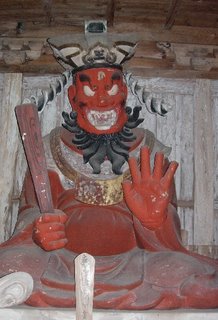
In 1714, the hall, which houses
the "Laughing Emma" (Emma-do) and carved out of wood,
was built. (8 feet tall).

You will meet this guy in hell.
(6 feet tall). Also, carved out of wood.
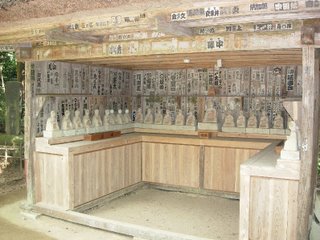
Some praying monk statues
in a small hall.
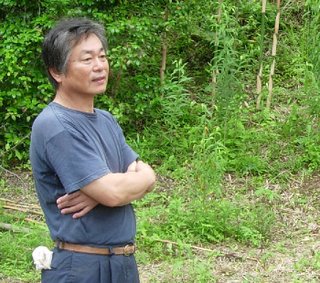
We also visited Kamiya Shouichi.
He lives also in Mashiko and is a 5 minute
walk away from Furiki-san, the tougei place we stayed at.
He is a former apprentice "deshi" of Shimaoka and worked with David McDonald.
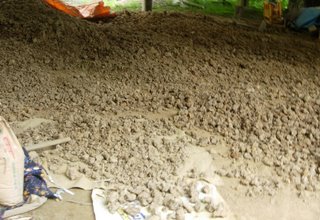 Shimaoko had told him, when he was going to build his own kiln, to find a place where was a clay deposit. It was across from his house and workshop.
Shimaoko had told him, when he was going to build his own kiln, to find a place where was a clay deposit. It was across from his house and workshop.He showed us the place.
Here clay is dug out and is drying.

After processing it, it is put in plaster molds and dried to a wedging state.

His ware from the gas kiln is very distinctive and beautiful. I bought a small cup "guinomi" from his showroom.
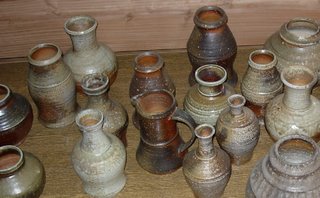
He fires his wood fire combination anagama-noborigama once a year. His forms are very playful.
MONDAY, JULY 10, 2006
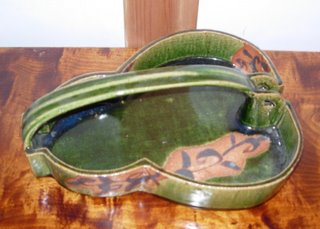 Matsuzaki Ken is born in 1950 in Tokyo and graduated from the Fine Arts Ceramics Department at Tamegawa University in 1972. Directly after that, he apprenticed for five years with Shimaoka Tatsuzo. He established his own kiln, "YuShin (Playful Spirit)" in 1978.
Matsuzaki Ken is born in 1950 in Tokyo and graduated from the Fine Arts Ceramics Department at Tamegawa University in 1972. Directly after that, he apprenticed for five years with Shimaoka Tatsuzo. He established his own kiln, "YuShin (Playful Spirit)" in 1978.Matsuzaki is challenging his craft with new forms and styles and won't become complacent about his work whatsoever. That always makes his work refreshing. He doesn't rehash his succesful styles over and over again. You can say for him that for any true artist the discovery of what lies within is as important as what is created. So, he has been busy creating, changing, daring, and stumbling and ultimately standing proud next to his wide range of works.
His homepage shows dozens of pieces: www.yuushin-gama.com and dare to brows. It is only Japanese.
We had a wonderful time visiting with him and his wife. We saw his special anagama kiln, which he can stoke from two sides.

Two stoke sided
Anagama(one chamber).
Two years ago, he built a new noborigama for his gold and purple "Shino", special whitish glaze. He showed us his workshop

Matsuzaki Ken with
some of his glazed
work.
and showroom, where we had some nice cold green tea, because, it was very muggy and hot. Mike and David again helped a lot with translating the Japanese.
They also talk some English. Hank knew him from the Pucker Gallery in Boston, where he had an exposition. He has some beautiful wood fired pieces and gold shino bowls. He also gave us a catalogue and on our way out even a small "Guinomo" (cup). Beautiful!
 Shimaoka Tatsuzo is born in 1919 in Tokyo.
Shimaoka Tatsuzo is born in 1919 in Tokyo.When Shimaoka was a teenager , wondering what to do when he grew up, he visited the Nihon Mingeikan (Japan Folk Crafts Museum in Tokyo) in 1938. There he discovered the beauty of Mingei advocated by Yanagi Soetsu (1889-1961). Shimaoka had found what he wanted to become and met the most passionate advocates of Yanagi's Mingei Movement: Hamada Shoji, Kawai Kanjiro and Bernard Leach.
 Shimaoka began making pottery in 1939 as a student at the Tokyo Institue of Technology's Department of Ceramics. Shimaoka joined Hamada's workshop as an appentice after graduation and four years later, built his own, independent kiln adjacent to his teacher's in Mashiko.
Shimaoka began making pottery in 1939 as a student at the Tokyo Institue of Technology's Department of Ceramics. Shimaoka joined Hamada's workshop as an appentice after graduation and four years later, built his own, independent kiln adjacent to his teacher's in Mashiko.Shimaoka developed his own personal style. He was designated a "Living National Treasure" by the Japanese government in 1996 for developeng a pottery technique where white slip is applied to rope impressions made in the surface of the pot when it is still wet: something he calls "Jomon Zogan".
 Shimaoka-san himself gave us a tour despite his old age and showed us his kilns, the workshops with throwing, decorating and glazing areas. David apprenticed with him for 2 years 27 years ago and Lee in 2000 for 3 years.
Shimaoka-san himself gave us a tour despite his old age and showed us his kilns, the workshops with throwing, decorating and glazing areas. David apprenticed with him for 2 years 27 years ago and Lee in 2000 for 3 years.Shimaoka-san talking to his "deshi".

Putting slip on a rope impressed vessel.

Scraping off the hardened white slip.

Platters drying in the sun.

We also went in his showroom. You always take your shoes off and walk carefully around. He was preparing for a show. His work is beautiful, but of course quite expensive.
We had tea in his house and we drank from his cups and had a nice talk. He knew quite some english, understood more then he could talk. Mike and David did most of the talking because of their Japanese language skills. We got a catalogue from him when we left and he joked, when he looked at it, that it was old work and that it was time to make some new designs. Good for him!
Hamada Shinsaku is Hamada's Shoji's second son. He is born in 1929 in Tokyo.

He studied Art and Craft at Waseda University before becoming an apprentice with his father at his pottery at Mashiko. In 1963 he came to the Leach potery with Shoji before traveling for a year visiting the USA as an assistant to him for his lecture on ceramic arts. At the Nihonbashi Mitsukoshi Store art Gallery in Tokyo in 1970 he held his first one-man exhibition. Since then he travelled extensively and held many exhibitions and Tougei(ceramic art) demonstrations.
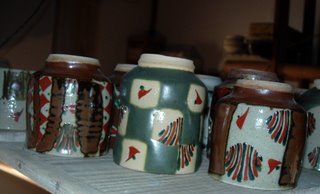
Glazed cups.
He lives next to the Reference Museum of which he is director. He showed us around his compound and saw his workshops and beautiful noborigama(climbing kiln), which he fires in spring and autumn. Summer and winter are either too hot or too cold.

The Noborigama.
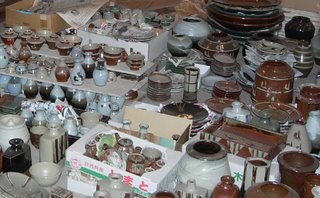
Ware ready to
be sold.
Assistants, "deshi", were glazing pots when we arrived. We received a book with pictures of his work in honor of his 77th birthday.
His son, Hamada Tomoo, is well known too.
SUNDAY, JULY 09, 2006
 On Sunday, we visited Gerd Knapper: a potter, ceramic artist, sculpture and person of lots of other trades: painter and decorator, restorer, art metal workshop assistant, sailor, photographer and architect.
On Sunday, we visited Gerd Knapper: a potter, ceramic artist, sculpture and person of lots of other trades: painter and decorator, restorer, art metal workshop assistant, sailor, photographer and architect.David, Lee, Hank, Craig, Jean (Lee's wife), Jim, Swanica, Mike and Gerd Knapper.
 We drove through the wonderful Tochigi prefecture country side with plenty of rice fields and beautiful flowers (red puppies, irisses) as we arrived at his Tarosaka studios and fabulous and world famous Japanese manor in Daigo-machi(town) with dormor windows and reed thatched roof. It was built about 170 years ago and Gerd Knapper restored and redesigned it in 1976.
We drove through the wonderful Tochigi prefecture country side with plenty of rice fields and beautiful flowers (red puppies, irisses) as we arrived at his Tarosaka studios and fabulous and world famous Japanese manor in Daigo-machi(town) with dormor windows and reed thatched roof. It was built about 170 years ago and Gerd Knapper restored and redesigned it in 1976.
We were greeted by him, his wife and oldest daughter. He is a very interesting, generous, hospitable and friendly man and offered us refreshments. He took us to the "Fukuroda no taki" (waterfalls) and gave us a delicious lunch with view of the falls.
On our return, he showed us his noborigama (climbing kiln), other kilns and workshops. In the fall, he will open a gallery in one of his barns.
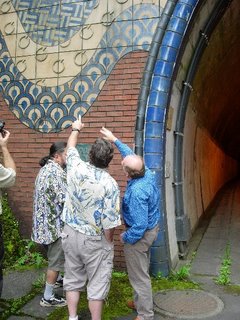
Gerd Knapper's prides include his family, house ceramics, sculptures and commissions. His ceramics are scattered in museums and houses all over the world.
He has been living in Mashiko for 6 years as the first foreigner potter before establishing himself in Daigo for 31 years by building his own kiln. He has been strongly influenced by the country and in turn strongly influences pottery in Japan. He has succeeded in combining the Japanese style with the technical expertise brought to Japan from his native Germany.
Knapper has done what no western ceramist had accomplished before him. He not only won both the prestigious "Minister of Education Award" and the no less prestigious "Prime Minister's Award", but he followed his distinctly individual vision and still was enormously successful with the Japanese public.

Knapper's art reflects his affinity for nature. Shells and flowers are among his recurring forms. He demonstrates respect for the achievements of Japanese potters, yet he is only Knapper the artist, who cannot be claimed by a country or style.
